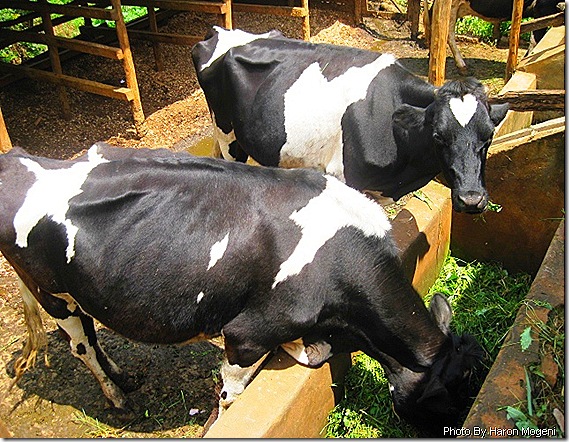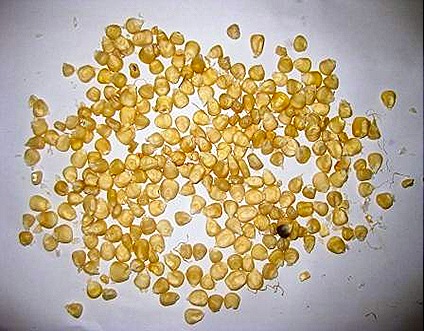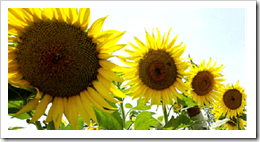Mr.. Mwangi started French bean farming 10 years ago after being frustrated by coffee millers___for a long time, earnings from coffee placed bread and butter on the table; but, not anymore!
In the 1990’s the international prices of coffee had gone down, there was also rampant corruption leading to losses to farmers; furthermore they were never paid in time!
Some farmers had to divorce themselves from coffee production; a crop reputed as the black gold of Kenya__ oh its luster had faded!
“I now earn a better income. Previously, I used to deliver my coffee berries to one of the millers, I don’t remember being paid on time; paying school fees for my children was a dream"
“I can now afford to pay school fees for my six children, feed them and buy some property__thanks to French-bean farming.” He says.
“I was able to diversify my farming to include, 5 dairy cows that give me an average of 80 litres per day earning me Ksh 2,400 which is an equivalent of $ 28.” “I am now out of the poverty bracket.” he quips!
This story of success is similar to that of many farmers- learn how this crop can transform your life by reading this article and sharing it with your friends!
Why french beans farming?
There is a high demand for crop in Europe throughout the year, this means that farmers can grow it year round and get market for the crop.
In fact it is the leading vegetable export from Kenya and it’s said that our french beans are the finest.
Secondly, the crop matures and is ready for harvest after 3 months from the sowing of the seeds.
The short maturity period allows farmers to recoup their investment after a short period.
Thirdly, the crop is harvested 3 times a week, for three to four months. Every time farmers harvest the crop, it is bought in cash by various brokers and traders.
This enables a farmer to have a healthy cash flow that allows him to undertake other activities like feeding his children, taking them to school and other home expenses; thus have a peace of mind.
lastly, one acre yields 4 tons of french beans; at a selling price Ksh 60 per kilo, farmer will earn Ksh 240,000 by the end of the harvest.
After deducting all his expenses, it has been reported,farmers make an average profit of 80,000 shillings per acre after three months of growing french beans.
Some enterprising farmers lease several farms from neighbors or friends who live in towns and are not able to farm; such farmers earn hundreds of thousands from french beans.
role FRENCH BEAN FARMING IN KENYA
French beans constitutes 40% of the vegetable exported from Kenya. In the export chain; we have farmers who grow the crop, middle men and exporters who contract farmers, airlines and logistics companies who are involved in shipping the product, the government as a regulator and the supermarkets in Europe where the crop is sold.
Over 100,000 farmers in The country are involved in the cultivation of the crop and over 200,000 have been employed in industries related to the crops production and marketing.
The export of the vegetable plays a key role in bolstering the foreign exchange the country earns from horticulture.
reasons of success of Kenya in french bean production
The country is successful in the production of the crops because we have suitable environmental conditions, a better human resource, better marketing strategy and good infrastructure.
With regard to the environment, the country lies astride the equator and has varying altitude ranging from 0-5199 Meters above sea level; a factor that enables year round production.
Most Kenyan farmers are fairly young, they are aged 40 and below, majority of who, have completed secondary education; therefore they can understand and comply to the quality requirements for export to the EU a principal market of Kenyan French beans.
This cannot be said of other African countries that are trying to compete with Kenya’s French bean industry.
The country’s geographical position is also suitable; one can fly to any African county from Nairobi- the capital city within four hours.
This geographical advantage has made Nairobi to be an international airline hub thus increasing the availability of airfreight-a paramount factor in export horticulture.
Large exporters also enter into joint ventures with Airlines to assured availability of airfreight space in cargo cabins.
The horticultural development authority,the private sector and ministry of agriculture have aggressively marketed the country for many years as a hub of horticulture.
Finally preferential trade agreement with the European union and other economic regional blocks have made Kenyan exports to gain access to such markets.
REGIONS WHERE FRENCH BEANS ARE PRODUCED
Production is concentrated around central Kenya; in areas of Nyeri, Kirinyaga, Mwea, and Meru because of the numerous rivers in the region that make year round production possible.
Many of agri-input companies operate within the region; drip lines, irrigation pumps, fertilizers, pesticides and technical information are always available to farmers.
The region’s proximity to Jomo Kenyatta international airport also makes it possible for the produce to arrive in Europe within 48 hours after harvest-when fresh condition.
Finally, the bean is adaptable to wide geographical altitudes and a variety of soils; from light sands to heavy clays, although, experts say it does better in well-drained loam soils rich in organic matter.
Ecological requirements
-
Altitude 0-1800 Meters above sea level.
-
Warm temperatures between 12-34 degrees; temperatures below 120 C encourage frost that is harmful to the crop on the other hand, temperatures above 340 C result to flower abortion.
-
A well distributed rainfall throughout the year, 600-1500 mm.
-
The soil should be well drained; a waterlogged soil will increase risk of root and collar rot, seed asphyxia during seed germination.
-
French beans are very sensitive to salinity; saline soils must be avoided.
-
Fertilizer applications must be split up and applied in several installments to avoid excess doses of salts.
Considerations before planting
Before planting French bean on your farm, it is important to consider which preceding crops were on the field.
Some crops share the same diseases and pests with French beans; planting French beans areas where such crops were results to a build-up of pests and diseases.
It’s possible that previously sowed crops may have depleted the mineral resources in the soil thus making it necessary to supply additional nutrients to the soil.
The table below indicates the crops to avoid, those that have no effect on the soil condition and those that are beneficial if they had preceded French bean.
| To be avoided as preceding crops | Not useful as preceding crop | Recommended as preceding crop |
| Peas, Beans
Potato
eggplant
Melon Cucumber
zucchini, Watermelon
Lettuce
Okra | Groundnut
Pepper, Celery, Lettuce
Carrot
Onion, Garlic,
Shallot | Cereals like (Maize, Sorghum and Millet) Fodder grass
Cabbage,Kale,turnip
Beetroot
Cassava
Sweet potato
Strawberry |
The Growth Cycle of french beans
During sowing the most important thing to consider the is seed depth.
Research has demonstrated that the most optimal depth is 3-5 cm in sandy soils, while for heavy soils a depth of 2 cm is sufficient.
| Period/timeline | Observation/activity |
| 0-10 days | Seedling emergence |
| 11-25 days | Vegetative phase |
| 35th day | Commencement of flowering |
| 50th day | Harvesting commences |
| 55-80 days | Harvest period |
The table above shows what a farmer should expect after sowing french beans.
Timing of the market is important; plant when the best prices are expected and in times of shortages. Flooding the market is disastrous to a farmer because the crop does not have local demand.
To insure yourself from total loss in seasons of overproduction, grow a variety of crops to diversify your source of income.
MANAGING DISEASES in french beans
The major disease of French beans is rust. It is caused by a fungus known as uromyces appendiculatus; fortunately it is effectively controlled two fungicides, Dithane M45 or Anvil.
To reduce the prevalence of this disease, avoid sprinkler irrigation; such irrigation wets the leaves thus providing a suitable condition for rust.
Where furrow irrigation is practiced, there is a high incidence of wilt and nematode attacks. The wilt is caused by a fungus known as fusarium oxysporum.
The best method of irrigation is drip irrigation; it allows direct application of water to the root zone.
Frequency of Harvesting
The date of seedling emergence depends on the variety of bean, the soil condition, and the altitude; factors that determine the commencement of harvesting.
It is expected that emergence will occur within 4-10 days. Flowering will commence after 28-35 days.
Farmers harvest French beans every Monday, Wednesday and Friday; days when they employ pickers to do the work for them.
On the days of harvest, buyers come and before the end of the day the produce is in a cold room in Nairobi awaiting export to Europe.
Harvesting lasts for 3-5 weeks and by the end of the harvest season, the farmer would have harvested 4-5 tons for every Hectare planted.
Application of Fertilizers
The table below gives an example of fertilizer regime that can be used to increase production.
Examples of fertilizer application (per Hectare) The figures are for quantity of input per hectare of actual crop
| Fertilization | Example 1
(Classic fertilization) | Example 2
(Alternative fertilization) | Example 3
Fertilization coupled with irrigation) |
| Basal dressing | 10-20 tons organic matter | 10-20 tons organic matter | 10-15 tons organic matter
100 Kg K2SO4
100 kg 18-46-0 |
Correct application 1
(1st hoeing) | 200-400 kg 10:10:20 | 200 Kg K2SO4
150 Kg DAP | 100Kg K2SO4
100Kg 18-46-0
25 Kg Urea
40 Kg/week of 16-9-26 (soluble fertilizers)
20 Kg/week of 0-52-32 (soluble fertilizers) |
Correct application 2
(2nd hoeing) | 150-300 kg 10:10:20 | 150 Kg KNO3
50 Kg DAP | 100Kg K2SO4
25 Kg Urea
40 Kg/week of 16-9-26 (soluble fertilizers)
20 Kg/week of 0-52-32 (soluble fertilizers) |
| Flowering to harvest | Foliar spray | Foliar spray | 40 Kg of KNO3 (soluble fertilizers) |
| Inputs N:P:K | 50-100/50-100/100-200 | 76/92/232 | 100/137/200 |
| N/K2O balance | 1/2 | 1/3 | 1/32 |
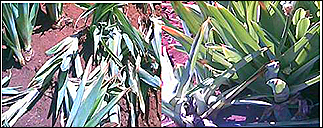 This annual flower is gaining popularity among small scale farmers because they are easy to grow, they yield higher returns to farmers. Thus many Non governmental organizations are promoting the cultivation of this flower on their poverty eradication efforts with great success.
This annual flower is gaining popularity among small scale farmers because they are easy to grow, they yield higher returns to farmers. Thus many Non governmental organizations are promoting the cultivation of this flower on their poverty eradication efforts with great success.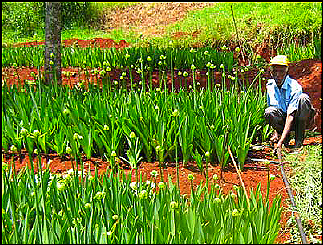

![clip_image001[1] clip_image001[1]](https://blogger.googleusercontent.com/img/b/R29vZ2xl/AVvXsEikO5ZjuWwj4i1lVZ_niG7Qu_ZyL_mu5JmjkOx2arQRT5sXd2pIrXr-X3lVS7hHGWCC9wwO9ixI1DZF5nxqB6Xbzmg4yeFslfZu1tOaE5RoV18Fo-jxT3n3v4gwbTKapTkJL2TmaEOtbqQ/?imgmax=800)





